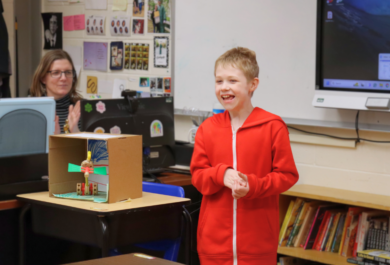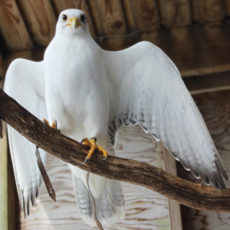Announcements

Last April a baby Great Horned owl was found in Brewster, New York. A nest had fallen and was destroyed, leaving the owl that was too young to fly, stranded. In a similar situation just one month later, a pair of Great Horned owls were discovered in Long Island, NY and transported to Green Chimneys by volunteers. All were presumed to be around two or three months old. Together, the three owlets (aka baby owls) began to heal and grow at Green Chimneys.
Much like when a student first arrives to attend Green Chimneys School and staff immediately begins planning for his or her return to the home school district, the moment the owls were brought to Green Chimneys, our animal experts began preparing for their release. A list of milestones was mapped. Owl size was monitored and food intake measured. Staff watched for signs that baby feathers were molting; that they were perching and eating independently. Anticipation built for one of the biggest developments: the trio learned how to fly. Eventually, the owls took up residence in our largest flight cage so that they could hone their flying skills. Staff began introducing elements of the hunt to the owls. Being able to dive, chase and capture live food such as rodents is essential to their real-life survival. All the while the owls experienced minimal contact with students and staff to better prepare them for life in the wild.
And then the day arrived. The day these owls and staff and students worked toward: release day. On a hill toward a more remote portion of the Green Chimneys Brewster campus, the three young Great Horned owls were quietly and successfully released. A fourth but more mature Great Horned was released too. A small gathering of students stood in silence to witness the send-off.
“It’s not only incredible bearing witness to a bird release – it’s an amazing experience to watch with Green Chimneys students who are building skills of their own. Our students are working toward returning to their home school districts. They’re learning while also helping the animals. It’s a great moment,” explains Wildlife Caretaker Dave Spillo.
Moments before the release Animal Caretaker Hannah Hughes asked students if they wanted to whisper any special messages to the owls before they were set free.
“Have a nice life,” one Green Chimneys student called out.
Each year more than 65 wildlife are cared for at the Paul C. Kupchok Wildlife Rehabilitation Center at Green Chimneys. While each rescue is greeted with the universal hope of rehabilitation and release, permanent injury can prevent some rescues from returning to the wild. Nearly 50 injured or imprinted wildlife reside at Green Chimneys. Our students, many of whom struggle with social, emotional and behavioral issues, transition from care-receiver to caregiver while helping to care for the 300+ animals at the Farm & Wildlife Center. Interactions with animals and nature are at the core of therapeutic educational programs.
Discover the role nature and animals play in helping children thrive

Crowned the best for falconry in medieval times, gyrfalcons were once reserved for kings. As the largest falcon in the world, with exquisite plumage ranging from bright white to deep charcoal, gyrs are revered for their powerful skill of flight. Their long wings make hunting waterfowl from 3,000-feet-high a feasible and fantastical feat. This falcon was flown in the sport of falconry for several years.